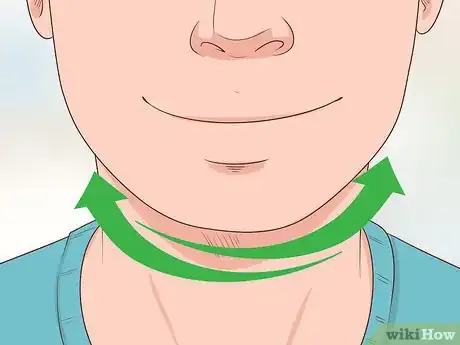This article was co-authored by Jonathan Stancato and by wikiHow staff writer, Kyle Hall. Jonathan Stancato is a Holistic Voice Coach and the Founder of Inside Voice, an approach to improving one's voice and singing abilities through a mind-body 5-octave approach developed while he was working at the Royal Academy of Dramatic Art in London. He serves clients online and in-person in the New York City metro area and has taught students in theatre conservatories, music festivals, mindfulness organizations, TED Conferences, colleges, choirs, and corporations. Jonathan has extensive training in extended voice (Richard Armstrong/Roy Hart), Hindustani classical vocals (Michael Harrison), and trance singing (Thomas Richards/Grotowski Workcenter).
There are 10 references cited in this article, which can be found at the bottom of the page.
This article has been viewed 171,728 times.
Are you a soprano or tenor who's hoping to delve down into the depths of those lower notes? While you may have mastered the ability to sing notes as high as the stars, developing your vocal range is an important part of becoming a truly fantastic singer. Start by outlining your natural register and pushing outwards into lower notes. Give yourself plenty of time to warm up and get in correct position before each singing session. You can also approach a vocal coach for help. With practice, you will be able to sing a range of notes that span from the top of the range down to the bottom.
Steps
Producing Low Notes
-
1Relax your tongue and mouth. Slide your jaw from side-to-side prior to singing. Move your tongue around your mouth before resting it close to your front teeth. If you feel pain in your jaw joints, pause before continuing to sing. If you are singing higher in pitch, push your tongue downwards.[1]
- You’ll notice that if you are trying to reach for a note, then your tongue might move around more. This can actually make it more difficult to hit the note that you are striving for.
-
2Stand up straight. Push your shoulder blades back and imagine holding a pencil in between them. Keep your back and neck straight with your face looking forward. Hunching over can compress your throat. This will make it more difficult to produce quality low notes.[2]
- If you are sitting while singing, try standing up to expand your range.
- To check your posture, look in a mirror. Practice correcting your posture until it feels natural.
Advertisement -
3Release a heavy sigh to warm-up. Your vocal cords have to be relaxed in order to produce low notes. Before you start singing, give yourself 5 minutes or more to warm-up. Make a sighing noise and try to carry it to the lowest, deepest pitch possible.[3] Repeat this same noise repeatedly until you feel relaxed and ready to sing.[4]
- Rolling your shoulders and rotating your neck can help you to relax while humming.
-
4Sing from your mouth and chin, not your throat and chest. One reason that singers often struggle with low notes is that they think they should be going lower into their body and singing from their chest and throat. However, doing so can cause tension and actually make singing low notes more difficult. Instead, try to sing from your mouth and chin area so you’re keeping your voice in your head, which will produce better low notes.[5]
- If it helps, try imagining that you have a golf ball at the front of your mouth and you don’t want it to fall back while you’re singing.
-
5Remember to use your breath when you're singing low notes. Singing low notes actually requires you to use more of your breath. If you don’t use your breath, you won’t be able to support the low notes you’re singing.[6] As you’re singing low notes, imagine that you’re launching your breath up through your throat and toward the front of your mouth.[7]
- Don’t let your breath get stuck back in your throat—you want it to be at the front of your mouth where you should be singing from.
Experimenting with Your Range
-
1Identify your natural register. Talk while placing your hand across your nose. Then, do the same thing with your hand flat on your chest. If you feel lots of vibrations in your nose for both exercises, then you have a nasal voice. More vibrations in your chest indicate that you have a chest voice. Equal vibrations in both areas means that you have a balanced voice naturally capable of a wide range of notes.[8]
- Singers with a chest voice often find it easier to hit lower registers. If you have a nasal voice, it may take more time and effort to consistently hit low notes, but it is still possible.
-
2Practice holding lower and lower notes in your range while singing “Mee.” Select a note in the middle of your vocal range. Then, start singing “mee” and continue on for as long as you are comfortable with. Keep the “mee” sound clear, clean, and without scratchiness. Then, attempt to move down notes in your range so see how far you can go.[9]
- As you sing “mee,” pay attention to your resonance. You should feel more facial vibrations as you head into lower notes.
- Don’t be concerned if your volume decreases when you sing “mee” in a lower register. This is normal.
-
3Work with a vocal coach. Vocal coaches are trained singers who can help you with your technique. They can help you develop your ranges properly and improve your tone without damaging your voice. Find a vocal coach near you by contacting music schools or the music departments at colleges in your area.[10]
- A professional vocal coach can also point out weaknesses and suggest ways to improve.
-
4Accept the natural limits of your voice. Not all singers are meant to hit the lowest notes. Continue to work on your range, but stop if your voice feels scratchy or sore. It’s also helpful to spend time developing the notes in the middle of your range, instead of continually trying to extend it out.[11]
Improving the Quality of Your Voice
-
1Practice humming for 15 minutes each day. Pick a number of songs that cover a wide expanse of notes from low to high. Then, spend some time daily mimicking these songs by humming to them. As you hum, concentrate on feeling the vibrations in your face as you go into the lower notes.[12]
- Place your hand gently against your face or throat to concentrate on actually feeling the vibrations.
- If you don’t feel any vibrations, keep practicing. Intermixing humming with singing might help, too.
-
2Try speaking out the lyrics or notes. Many people speak with chest voice instead of head voice. To get the notes into the low range, start by speaking the words in your lower register. This can put your vocal chords in the right position.
- After saying the words, sing the same words. Your vocal chords should be at the correct spot to sing in the lower register.
-
3Move the mic closer to your mouth. As soon as you start to dip into a low note, pull the mic closer to your lips. This will help to create a deep, amplified sound. When you head into a high note, move the mic away from your mouth to get a clear sound.[13]
- The mic should not be touching your lips or you’ll potentially end up with sputtering noises.
-
4Move into a slight smile. For some people, it helps to curl your lips upwards just a bit when singing low notes. This lip placement can encourage you to open your mouth and throat up more, which can create a deeper sound. Experiment with exactly how much to smile. If you do too much, it can weaken your tone and be hard to hold intact.[14]
- Similarly, lifting your eyebrows may improve your sound as well, but that’s not as certain.
Expert Q&A
-
QuestionHow do I warm up so I can sing low notes?
 Jonathan StancatoJonathan Stancato is a Holistic Voice Coach and the Founder of Inside Voice, an approach to improving one's voice and singing abilities through a mind-body 5-octave approach developed while he was working at the Royal Academy of Dramatic Art in London. He serves clients online and in-person in the New York City metro area and has taught students in theatre conservatories, music festivals, mindfulness organizations, TED Conferences, colleges, choirs, and corporations. Jonathan has extensive training in extended voice (Richard Armstrong/Roy Hart), Hindustani classical vocals (Michael Harrison), and trance singing (Thomas Richards/Grotowski Workcenter).
Jonathan StancatoJonathan Stancato is a Holistic Voice Coach and the Founder of Inside Voice, an approach to improving one's voice and singing abilities through a mind-body 5-octave approach developed while he was working at the Royal Academy of Dramatic Art in London. He serves clients online and in-person in the New York City metro area and has taught students in theatre conservatories, music festivals, mindfulness organizations, TED Conferences, colleges, choirs, and corporations. Jonathan has extensive training in extended voice (Richard Armstrong/Roy Hart), Hindustani classical vocals (Michael Harrison), and trance singing (Thomas Richards/Grotowski Workcenter).
Voice Coach Start at a higher note and sing an "ooo" sound. Slowly lower the pitch of your voice as you sing to make your voice as low as it can go.
Start at a higher note and sing an "ooo" sound. Slowly lower the pitch of your voice as you sing to make your voice as low as it can go. -
QuestionWhat tips can I use to hit a note at the lowest end of my range?
 Community AnswerI know it sounds weird, but do not warm up as much. Normal low notes can be easier to hit if your voice is less warmed up.
Community AnswerI know it sounds weird, but do not warm up as much. Normal low notes can be easier to hit if your voice is less warmed up. -
QuestionI'm a girl and my voice range is E3 to G5 with some strain, though I can easily hit D3 when I'm sick with a sore throat. I personally would like a wider voice range, but is mine normal for an alto?
 Community AnswerA typical alto voice range is from G3 to F5, your range is actually slightly larger than that of many altos!
Community AnswerA typical alto voice range is from G3 to F5, your range is actually slightly larger than that of many altos!
Warnings
- If your throat feels painful or scratchy, stop singing as you could cause long-term damage. Similarly, don’t practice singing when you are sick.⧼thumbs_response⧽
References
- ↑ https://www.savvy.is/blog/3-singing-techniques-to-help-you-hit-high-or-low-notes
- ↑ http://cmed.faculty.ku.edu/gummposture/posture.html
- ↑ Jonathan Stancato. Voice Coach. Expert Interview. 31 March 2020.
- ↑ https://www.musical-u.com/learn/3-singing-exercises-to-improve-your-vocal-pitching/
- ↑ https://www.youtube.com/watch?v=T1Cpxjy1IeA
- ↑ Jonathan Stancato. Voice Coach. Expert Interview. 31 March 2020.
- ↑ https://www.youtube.com/watch?v=T1Cpxjy1IeA&feature=youtu.be&t=135
- ↑ https://www.becomesingers.com/techniques/how-to-sing-bass
- ↑ https://www.susananders.com/article-8-mastering-low-notes
- ↑ https://www.vocaladvancement.com/en-us/blog/article/difference-between-singing-teacher-voice-coach
- ↑ https://www.becomesingers.com/techniques/how-to-sing-bass
- ↑ https://www.susananders.com/article-8-mastering-low-notes
- ↑ https://www.myhappyvoice.com/sing-low-notes/
- ↑ https://www.susananders.com/article-8-mastering-low-notes
About This Article
To sing a low note, you first need to relax your vocal chords, which you can do by drinking water or releasing a sigh. Support the low notes by using your diaphragm, which is located right below your ribs, to breathe and pushing your stomach in. Remember to maintain good posture and sing from your mouth and chin, not your throat and chest! For tips on how to understand different vocal registers and when to get help from a vocal coach, read on!










































































